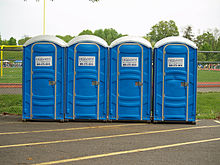Portable toilet

Ùnyì ubiko kèkè kumanekepkali (colloquial terms: thunderbox, porta-john, porta-potty or portaloo) ubiko kumanekekpali lulè kpaì eneka, ìya cheyi kimachini ákpáli lulè agunu truck and crane. Ojileñ dùkpa kumachetaneñ, kpáki egwucheligañ, manyù unyuenekaicheyi. Yidekekele ómemele machenekeduchekwu ojojiojoji, ujiwenñu èfèwo kimabinyonyoñ manekeduchekwu omo, ùgbó kumachodo uyu, abokumalotuujeju, efuoko omí, ùgbó kùma kù ùnyì , manyù ugbo umachifimu manyù ugbo kamóne jowewe kunyi madomuñ. Ójìle ubiko kèkè chedama kpáí onobulè manyi ènèkèlè máche kùmadó igbede oná tó. Chenu ubiko kídè kèkè kumadaretó tu èjèfu ètè kìyanagbu ubiko defuñu.
Ubiko kèkè mádu eñu tọ kì lotaneñu dabicheligañu , idabuñ septic tank, nor is plumbed efì municipal system kóló tèfísewage treatment plant. Eyi chemical ubiko magbojima kìchì ojilẹ ubiko kèkè ámá abiọmune dọmì gè, agunu itu-yimu du kpelu uña ubiko, composting ubiko, unyi ubiko akpẹ, boketi, freezing toilets and incineration toilets. Eyi boketi ubiko yiche lọla efì amì ubiko .


Eyi chemical ubiko ágbá human waste in efì taki manyù edù chekwù chemicals kì nèkè bù uluñ lọ. Eyi chemicals yì nèkè dábí máskí the uku maki dabu biocides that hinder odor-causing bacteria from multiplying, ajeñ uluñ ke dekeke. Chemical yì ubiko manyù eyì kidefu okọ ojálè manyù okọ anẹ (ojileñu chi vacuum icheliga yiche abajóyì ), kiya chelọla.

elola ubiko kèkè mánè kẹ dù lotulẹ tirela (caravans, camper vans) manyù efì okọ ómì kẹkẹ. Máñu dọ oduñ kì "cassette toilet" or "camping toilet", efì odu brand kimu du generic trademarks. The Oxford English Dictionary lists "Porta Potti" ("kpai arbitrary respelling") as "A proprietary name for: eyì kekẹ ómemele chemical toilet, madù chekwù campers", and gives mostly American examples from 1968. The OED gives this proprietary name a second meaning, "a small prefabricated unit containing a toilet, designed for easy transportation and temporary installation esp. outdoors", which Wikipedia covers under chemical toilet.
Odu ómùnẹ kulọla efì British English is "Elsan", egba odo kpọbi odọ1925. According to the Camping and Caravanning Club, "eñyini yì elì campsites má dọ Chemical Disposal Points as Elsan Disposal Points atódù of the history and popularity of the brand." The Canal and River Trust uses both brand names, in lieu of any unbranded term.
One colloquialism for these simple toilets is the "bucket and chuck it" system, although in fact they no longer resemble an open bucket (see bucket toilet). These are designed to be emptied into sanitary stations connected to the regular sewage system. These toilets are not to be confused with the types that are plumbed in to the vehicle and need to be pumped out at holding tank dump stations.
Urine-diversion dehydration toilets
[nwọ́che | nwó étéwn che]Portable urine-diversion dehydration toilets are self-contained dry toilets sometimes referred to as "mobile" or "stand-alone" units. They are identifiable by their one-piece molded plastic shells or, in the case of DIY versions, simple plywood box construction. Most users of self-contained UDDTs rely upon a post-treatment process to ensure pathogen reduction. This post-treatment may consist of long-term storage or addition to an existing or purpose-built compost pile or some combination thereof. The necessity of a post-treatment step hinges upon the frequency and volume of use. For instances of infrequent or very modest seasonal use, a post-treatment phase might be deemed unnecessary due to the lower accumulation of waste, simplifying the overall disposal process.
A commode chair (a chair enclosing a chamber pot) is a basic portable toilet that was used, for example, in 19th-century Europe.

The close stool, built as an article of furniture, is one of the earliest forms of portable toilet. They can still be seen in historic house museums such as Sir George-Étienne Cartier National Historic Site in Old Montreal, Canada. The velvet upholstered close stool used by William III is on display at Hampton Court Palace; see Groom of the Stool.
Early versions of the "Elsan chemical closet" ("closet" meaning a small room, see water closet, WC, and earth closet) were sold at Army & Navy Stores. Their use in World War II bomber aircraft is described at some length by the Bomber Command Museum of Canada; in brief, they were not popular with either the flying crew or the ground crew.
African-Americans living under Jim Crow laws (i.e. before the Civil Rights Act of 1964) faced severe challenges. Public toilets were segregated by race, and many restaurants and gas stations refused to serve black people, so some travellers carried a portable toilet in the trunk of their car.
Since 1974, Grand Canyon guides rafting on the Colorado River have used ammo boxes as portable toilets, typically with a removable toilet seat, according to the Museum of Northern Arizona in Flagstaff, Arizona.

A slang term, now dated or historic, is a "thunder-box" (Oxford English Dictionary: "a portable commode; by extension, any lavatory"). The term was used particularly in British India; travel writer Stephen McClarence called it "a crude sort of colonial lavatory". One features to comic effect in Evelyn Waugh's novel Men at Arms:
- Accessible toilet
- Dignified Mobile Toilets, a mobile public toilet system from Nigeria
- Sanitation
- Telescopic toilet
References
[nwọ́che | nwó étéwn che].mw-parser-output .reflist{font-size:90%;margin-bottom:0.5em;list-style-type:decimal}.mw-parser-output .reflist .references{font-size:100%;margin-bottom:0;list-style-type:inherit}.mw-parser-output .reflist-columns-2{column-width:30em}.mw-parser-output .reflist-columns-3{column-width:25em}.mw-parser-output .reflist-columns{margin-top:0.3em}.mw-parser-output .reflist-columns ol{margin-top:0}.mw-parser-output .reflist-columns li{page-break-inside:avoid;break-inside:avoid-column}.mw-parser-output .reflist-upper-alpha{list-style-type:upper-alpha}.mw-parser-output .reflist-upper-roman{list-style-type:upper-roman}.mw-parser-output .reflist-lower-alpha{list-style-type:lower-alpha}.mw-parser-output .reflist-lower-greek{list-style-type:lower-greek}.mw-parser-output .reflist-lower-roman{list-style-type:lower-roman}
